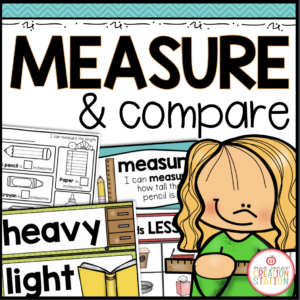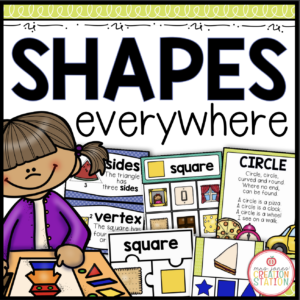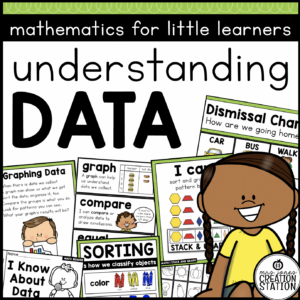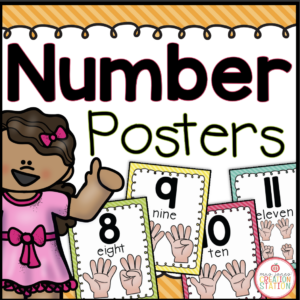Menu
This pack includes whole group, small groups and independent resources that may be used for introducing, teaching, reviewing and assessing number sense to ten. For example, you’ll find lesson plans with 5 mini-lessons, 2 center activities and an interactive page is available for each week of instruction.
Buy the Math Pack for Little Learners and save!!!
Lesson Plans:
Follow these lesson plans or use the ideas to supplement your curriculum. There are 4 weeks or 20 lesson plan ideas covering number sense to ten.
Counting Poster:
During this lesson, use this poster to teach learners different counting strategies to understand number sense to ten.
Vocabulary Cards:
During this unit, post these cards on the math wall during the unit to refer to as new words are introduced.
All About the Number Pocket Chart:
During this unit, use this chart throughout the unit to learn about each number. This chart includes the number word, one-to-one correspondence, number order, tallies, ten frame, counting up and down, number bond and number line. Laminate the pieces, place on a pocket chart and use a dry erase marker to complete.
Number Book:
During this unit, have learners complete a page of this book after the pocket chart is completed together as a whole group. This book includes rainbow writing, numeral tracing, tally, ten frame and counting for each number to 10.
Interactive Notebook:
During this unit, have learners complete an interactive notebook page each week as independent practice. These pages include 1-3, 4-6, 7-9, 10 and number order and making 5 and 10.
One to Three:
During this lesson, read the story of the Three Little Pigs and use the resources included to practice 1 to 1 correspondence together.
Four to Six:
Another option, read the story of the Six Crows and use the resources included to practice counting and subitizing.
Seven to Nine:
Next, read the story of the Nine Ducks Nine and use the resources included to teach a number line, 1 to 1 correspondence and counting down.
Ten:
Also, read the story of the Ten Fireflies and Fall Counting and use the resources included to review and practice counting, reading and writing 1 through 10.
Making 5 and 10
Finally, read the story Five Stinky Socks and Ten Little Rubber Ducks and use the resources included to practice composing and decomposing 5 and 10.
Dump Truck Numbers:
For this center, use the number mats and two-sided counters to practice making the numbers 5 and 10. Use the five and ten frame or introduce number sentences.
Writing Numerals:
During this center, have learners use the numeral tracing mats and race cars to practice tracing numerals.
Number Mats:
For this center, have learners use the number mats and playdough or a dry erase marker to form and count each number.
Number Puzzles:
During this center, have learners complete the puzzle for each number.
Subitizing Clip Cards:
During this center, have learners look at the picture and clip the correct number with a clothespin.
Ten Frame Clip Cards:
For this center, have learners look at the ten frame and clip the correct number with a clothespin.
Counting Gumballs:
During this center, have learners count the correct number of gumballs for each mat.
Number Line Road:
For this center, have learners place the cars in order on the road to create a number line.
Number Match Pocket Chart:
Have learners match the numeral, number word and picture card on a pocket chart.
Making 5 and 10 Gumballs:
Have learners make 5 or 10 using the gumball mats and two-sided counters.
Number Bond:
Finally, have learners use two-sided counters to make 5 and 10 on the number bond mats.
CCSSK.CC.A.2
Count forward beginning from a given number within the known sequence (instead of having to begin at 1).
TEKSMA.K.1.C
Mathematical process standards. The student uses mathematical processes to acquire and demonstrate mathematical understanding. For example, the student is expected to: select tools, including real objects, manipulatives, paper and pencil, and technology as appropriate, and techniques, including mental math, estimation, and number sense as appropriate, to solve problems;
TEKSMA.K.2.A
Number and operations. The student applies mathematical process standards to understand how to represent and compare whole numbers, the relative position and magnitude of whole numbers, and relationships within the numeration system. For example, the student is expected to: count forward and backward to at least 20 with and without objects;
How can I see what is new in the MJCS store?
Be the first to know about new discounts, freebies, and new products. You can also subscribe to our newsletter to receive access to resources only available to MJCS subscribers, as well as, special offers and ideas!
How can I get credit for my TpT purchases?
Go to your account button at the top of the page. Under the “Buy” section, click “My Purchases “. Beside each purchase you’ll see a Provide Feedback button. Simply click the button and you will be taken to a page where you can give a quick rating and leave a comment for the product. Each time you give feedback, TpT gives you feedback credits that you use to lower the cost of your future purchases. Please leave detailed feedback for each resource, so we are able to create better resources for teachers and students.
How can I find a certain activity in a large PDF file?
If the resource you purchase has a variety of activities compiled into one PDF find the table of contents and click on the activity title. This should take you to that specific activity in the resource.
What can I do if I have a question about a resource?
If you have any questions regarded a resource before purchasing please email me at mrsjonescreationstation[at]gmail.com. Once you have purchased the resource you may use the “Product Q and A” tab on the product page to ask a question, as well.
How do I know if a resource has been updated?
Go to your account button at the top of the page. Under the “Buy” section, click “My Purchases “. Choose to “sort by: recently updated” to see what resources have been updated since you downloaded them last. You can download any updates from there. If a file has been updated, you will see a notification under the resource that says “Newly Updated – Download for Free!”
This item is a paid product created by Mrs. Jones’ Creation Station, Inc. Copying any part of this product, redistributing, selling or placing it on the internet in any form is strictly forbidden and is a violation of the Digital Millennium Copyright Act (DMCA). Thank you for respecting our work!
YES, YOU CAN…
NO, YOU CAN’T…
Click here for a detailed post with step-by-step directions.
You will need to download fonts specified in the resource and install it on your computer before downloading the editable file.
Install the most recent version of Adobe Reader onto your computer. If you have any problems editing, viewing or printing a file make sure your Adobe Reader is updated.
Now you can download the file to your computer. Once the file has downloaded open in Adobe Reader. You should be able to view the editable fields and the text should match the product description. If you have any problems editing the file, make sure you have followed the directions above and then contact me at mrsjonescreationstation[at]gmail.com




